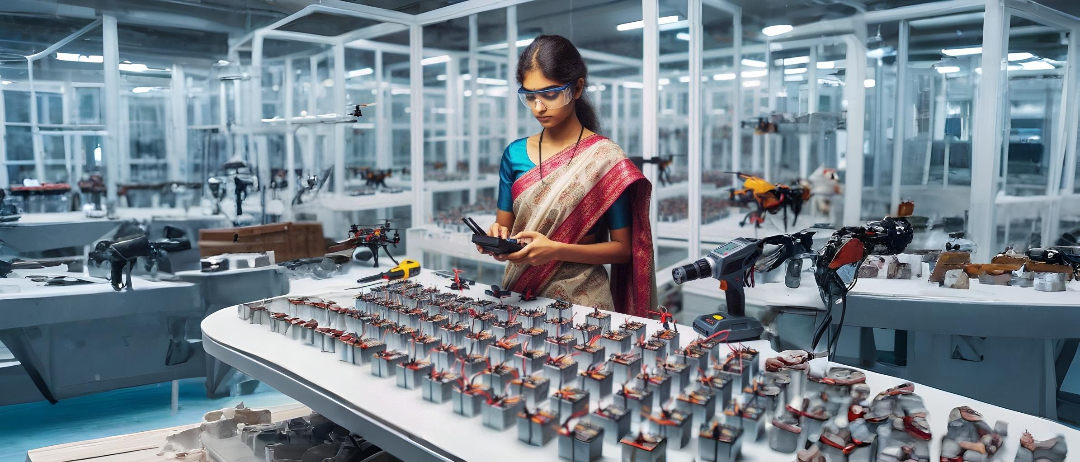How to Start a Drone Battery Manufacturing Plant: Market Insights and Business Plan
The drone industry is soaring to new heights, with applications ranging from aerial photography to delivery services and military operations. A crucial component powering this innovation is the drone battery, creating a lucrative opportunity for entrepreneurs to set up a drone battery manufacturing plant. This article explores the market size, demand, customer segments, and a robust business model for entering this thriving industry.

Drone Battery Market Size and Growth
The global drone battery market is estimated to be valued at ₹8,200 crore (over $1 billion) in 2025, with a compound annual growth rate (CAGR) of 15%. The rapid adoption of drones in industries like logistics, agriculture, and surveillance is driving the demand for advanced and efficient batteries. Innovations like high-density Lithium Polymer (LiPo) and Lithium High Voltage (LiHV) batteries further fuel market growth.
Key Drivers of Demand
- Commercial Drones: Drones for delivery, mapping, and inspection services require high-performance batteries.
- Consumer Drones: Hobbyists and enthusiasts form a growing segment demanding cost-effective and durable batteries.
- Military and Surveillance: Governments globally invest heavily in drone technology, driving demand for long-lasting, reliable batteries.
- Specialized Applications: Drones for agriculture, mining, and disaster management increasingly rely on advanced batteries.
Target Customers
- Drone Manufacturers: Bulk buyers requiring custom battery solutions.
- Retail Distributors: Serving end-users and small drone businesses.
- E-commerce Platforms: Offering direct-to-consumer sales.
- Government Agencies: Procurement for defense and public services.
- Agricultural Companies: Drones used for crop monitoring and spraying.
Business Model Canvas for a Drone Battery Plant
| Key Components | Details |
|---|---|
| Value Proposition | High-performance, durable, and cost-effective drone batteries. |
| Customer Segments | Drone manufacturers, retailers, government agencies, agricultural firms. |
| Channels | Direct sales, e-commerce, partnerships with drone companies. |
| Customer Relationships | Customizable solutions, reliable support, and maintenance services. |
| Revenue Streams | Battery sales, maintenance contracts, and bulk orders. |
| Key Resources | Advanced machinery, skilled workforce, raw materials (Li-ion, LiPo cells). |
| Key Activities | Battery design, production, quality testing, and distribution. |
| Key Partnerships | Suppliers of raw materials, logistics providers, drone manufacturers. |
| Cost Structure | Manufacturing, R&D, marketing, certifications, and labor costs. |
Steps to Set Up a Drone Battery Plant
- Market Research: Analyze target customers, competitors, and pricing trends.
- Location Selection: Choose an area with access to skilled labor, raw materials, and logistics.
- Infrastructure: Set up a manufacturing facility with advanced machinery for battery assembly and testing.
- Raw Material Procurement: Establish reliable suppliers for lithium cells, electrolytes, and separators.
- Regulatory Compliance: Obtain necessary certifications and adhere to safety standards.
- Team Hiring: Build a team of engineers, technicians, and business staff.
- Marketing and Sales: Develop a robust online presence, partner with drone manufacturers, and attend industry expos.
Drone Battery Specifications for Different Use Cases
- Consumer Drones:
- Battery Type: Lithium Polymer (LiPo)
- Capacity: 2000-5000 mAh
- Voltage: 7.4V to 11.1V
- Key Features: Lightweight, cost-effective.
- Flight Time: 20-30 minutes
- Commercial Delivery Drones:
- Battery Type: Lithium High Voltage (LiHV)
- Capacity: 5000-10000 mAh
- Voltage: 14.8V to 22.2V
- Key Features: High energy density, long flight times.
- Flight Time: 45-90 minutes
- Agricultural Drones:
- Battery Type: Lithium-Ion (Li-ion)
- Capacity: 10000-20000 mAh
- Voltage: 22.2V to 29.6V
- Key Features: Durable, supports heavy payloads.
- Flight Time: 30-60 minutes (depending on payload)
- Military and Surveillance Drones:
- Battery Type: Advanced Lithium-Ion or Solid-State Batteries
- Capacity: 15000-30000 mAh
- Voltage: 29.6V and above
- Key Features: Long endurance, reliability in extreme conditions.
- Flight Time: 3-6 hours
- Racing Drones:
- Battery Type: High-Performance LiPo
- Capacity: 1300-1800 mAh
- Voltage: 14.8V
- Key Features: High discharge rate, optimized for speed.
- Flight Time: 5-10 minutes (optimized for speed)
Estimated Costs for Setting Up a Drone Battery Plant
- Machinery and Equipment:
- Basic machinery (assembly tools, battery testers): ₹50,00,000 – ₹1,50,00,000
- Advanced machinery (automated production lines): ₹1,50,00,000 – ₹3,00,00,000
- Raw Materials:
- Lithium cells, electrolytes, separators: ₹25,00,000 – ₹50,00,000 (initial stock).
- Maintenance Costs:
- Facility and machinery maintenance: ₹20,00,000 annually.
- Transportation and Logistics:
- Setup of supply chain and distribution: ₹10,00,000 – ₹30,00,000.
- Operational Costs:
- Labor, utilities, and certifications: ₹50,00,000 – ₹1,00,00,000 annually.
Licenses, Rules, and Regulations in India
- Factory License:
- Obtain a factory license under the Factories Act, 1948, to establish a manufacturing unit.
- Pollution Control Clearance:
- Get clearance from the State Pollution Control Board to comply with environmental regulations.
- BIS Certification:
- Bureau of Indian Standards (BIS) certification for quality assurance of batteries.
- MSME Registration:
- Register under the Ministry of Micro, Small & Medium Enterprises for financial benefits and government schemes.
- GST Registration:
- Mandatory GST registration for taxation purposes.
- Electrical Safety Certification:
- Ensure compliance with electrical safety standards for lithium-ion and other high-energy batteries.
- Import-Export Code (IEC):
- Necessary for importing raw materials and exporting finished products.
- Drone Ecosystem Compliance:
- Align with DGCA (Directorate General of Civil Aviation) regulations for drone ecosystem compatibility.
- Fire Safety Clearance:
- Secure fire safety certification for the plant.
- Employee Welfare Compliance:
- Adhere to labor laws, including Employees’ Provident Fund (EPF) and Employees’ State Insurance (ESI).
By addressing the growing demand for drone batteries, entrepreneurs can establish a profitable business in a high-growth industry. With the right resources, partnerships, and market insights, a drone battery plant can take your entrepreneurial journey to new heights.
[kaya_qrcode title=”Drone Battery Manufacturing Business Model” title_align=”alignleft” content=”https://storelink.online/blog/index.php/2025/04/10/setup-drone-battery-plant/” ecclevel=”L” border=”4″ color=”#000000″ bgcolor=”#FFFFFF” align=”alignnone” url=”https://storelink.online/blog/index.php/2025/04/10/setup-drone-battery-plant/” new_window=”1″ download_align=”alignnone”]
